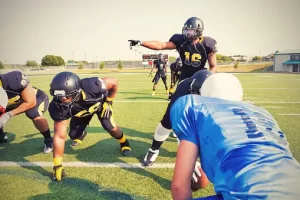A play-action in football is a strategic move used by offenses to deceive the opposing defense, keeping them off balance during the game. This tactic particularly targets defenses that are heavily focused on stopping the running game. By understanding the mechanics of a play-action, you will better grasp how football teams use deception to create opportunities for big plays.
The play-action pass starts with what appears to be a running play; however, it quickly morphs into a passing play. This deceptive transition is designed to make the defense believe the offense is executing one type of play—typically a run—only to reveal that it’s a different type of play, such as a pass. As a result, play-actions can lead to significant gains, particularly when the defense is caught off guard.
In American football, the quarterback plays a crucial role in the play-action pass. The sequence begins with the quarterback receiving the snap, either from a shotgun formation or under center. Then, the offensive blockers engage the defense at the line of scrimmage as if they were blocking for a run play. The quarterback fakes a handoff or a run, luring the defense into the ruse, and then steps back to unleash a pass, often going for a long throw. By understanding these dynamics, you can see how a well-executed play-action can lead to significant advantages for the offense.
Contents
Understanding Play Action
Basics of Play Action
Play action is a deceptive strategy used in football to trick the defense into thinking the offense is running the ball. This tactic can be highly effective in throwing off the defense and allowing the quarterback to complete a pass, often to an open receiver downfield.
The play begins with the quarterback receiving the snap either from shotgun formation or under center. After the snap, the offensive blockers engage the defense at the line of scrimmage as if they were blocking for a run play. Meanwhile, the quarterback fakes handing off the ball to the running back, making it appear as though the play is a run. In reality, the quarterback keeps the ball and looks to pass it to an open receiver.
Different Types of Play Actions
There are several variations of play action that can be used to catch the defense off guard. Some common types include:
- Play-Action Rollout: This play has the quarterback fake the handoff and then roll out to either the left or the right side of the field, looking for an open receiver. This movement can help create additional separation from the defense and extend the amount of time the quarterback has to throw the ball.
- Play-Action Bootleg: Similar to the rollout, a bootleg involves the quarterback faking the handoff and then rolling out to the opposite side of the field from the run fake. This play can be particularly effective against aggressive defenses that bite hard on the run fake, leaving the quarterback with space to make a throw.
- Play-Action Screen: In this play, the quarterback fakes the handoff and quickly throws a screen pass to a receiver or back who has slipped out from the line, often with the help of blocking from offensive linemen or other players. The goal is to exploit the defense’s focus on stopping the fake run, creating an opportunity for the playmaker to run down the field.
Understanding and utilizing different types of play actions can help make an offense in football more dynamic and hard to defend, opening up opportunities for big plays and scoring drives.
Offensive Strategies
Quarterback’s Role
In a play action, the quarterback’s primary responsibility is to sell the fake handoff to the running back convincingly. This can involve using appropriate body language, carrying out a proper fake handoff motion, and hiding the ball from the defense’s view. Once the fake is sold, the quarterback must quickly scan the field, identify open receivers, and execute an accurate pass before the defense can recover from the deception.
Running Back’s Role
The running back plays a crucial role in the success of a play action. They must sell the fake run convincingly by starting their run as if they have the ball. Typically, this involves:
- Accelerating quickly after the snap
- Mimicking the typical body language during a run play
- Following the designed run route without the ball
By doing so, the running back can draw the attention of the defense and create more space for the wide receivers to get open downfield.
Wide Receiver’s Role
Wide receivers are responsible for exploiting the space created by the fake run in a play action play. Their job during a play action involves:
- Running precise routes designed to exploit weaknesses in the defensive coverage
- Staying aware of the developing play and adjusting their routes as needed
- Quickly identifying when they are open and signaling to the quarterback
- Securing the pass and making a big play after the catch
The success of a play action relies on the coordinated effort of the entire offense, from the quarterback to the running back and wide receivers. When executed correctly, this deceptive play can result in significant gains, keeping defenses off balance and opening up additional offensive opportunities.
Defensive Countermeasures
Linebacker’s Responsibility
Linebackers play a key role in defending against play action passes. Their ability to recognize the fake and adjust their positioning is crucial. When a play action is executed, linebackers must:
- Maintain their responsibilities in both run and pass coverage.
- Quickly identify whether it is a run or a pass play.
- Keep their eyes on the quarterback and the backfield to react appropriately.
By staying disciplined and reacting quickly to the play, linebackers can help neutralize the deception created by a play action pass.
Defensive Back’s Responsibility
Defensive backs also have important responsibilities in defending against play action passes. Their main tasks include:
- Keeping their focus on their receiver instead of biting on the run fake.
- Maintaining proper depth and coverage alignment in case of a deep pass.
- Communicating with teammates about potential route combinations and adjustments.
Defensive backs must remain disciplined and avoid committing to the run too early, which could leave receivers open downfield for big plays.
Advantages and Disadvantages
Effectiveness of Play Action
Play action is an effective strategy in football because it aims to deceive the defense into thinking the offense is going to run the ball, often causing the defense to react accordingly. This can lead to receivers being left open downfield, increasing the chances of a successful pass completion. It also helps to keep the defense off balance, allowing for more flexibility in offensive play-calling. Some of the advantages of play action include:
- Creates misdirection and confusion for the defense
- Opens up passing lanes for the quarterback
- Allows for offensive creativity and unpredictability
Common Limitations
However, play action can also have its limitations. It relies heavily on the success of the offense’s running game, meaning if the defense is not worried about the run, play action may not be as effective. Quarterback skill also plays a significant role in executing play action, as they must be capable of selling the fake and delivering an accurate pass. Some of the limitations of play action include:
- Requires successful running game to be effective
- Dependent on quarterback skill
- Can be difficult to execute against disciplined defenses
While play action has both advantages and disadvantages, it remains a crucial aspect of a balanced offensive strategy in football.
Oklahoma running Play Action GT Counter with a TE Glance pic.twitter.com/xLee8scBVJ
— Coach Dan Casey (@CoachDanCasey) March 30, 2021
Famous Play Action Plays
One of the most famous play action plays in NFL history took place during Super Bowl XLIX between the New England Patriots and the Seattle Seahawks. Tom Brady, known for his expertise in executing play action passes, connected with wide receiver Julian Edelman for the game-winning touchdown. This play action pass, disguised as a run, allowed Edelman to slip past the defenders and secure the catch.
It didn’t take long for Julian to build a special rapport with a guy who wore 12 for the Patriots.
In their sixth season together, Brady and Edelman connected for the go-ahead TD in Super Bowl XLIX. Julian led all WRs in receptions and receiving yards in the 2014-15 playoffs. pic.twitter.com/BRgo2hT885
— NFL (@NFL) April 12, 2022
Another notable play action pass occurred in the 2018 NFC Championship Game between the Minnesota Vikings and the Philadelphia Eagles. Quarterback Nick Foles executed the “Philly Special” play, a creative and deceptive play action in which Foles acted as a receiver while backup tight end Trey Burton threw the pass. This play resulted in a touchdown and a memorable moment in the Eagles’ journey to winning their first Super Bowl.
4 years ago today, the Philly special rocked the NFL world during Super Bowl LII. (via @NFLFilms) pic.twitter.com/75Q3g6Jnwd
— NFL (@NFL) February 4, 2022
In the 2013 AFC Championship game, Peyton Manning of the Denver Broncos demonstrated the power of play action against the New England Patriots. Manning faked a handoff to the running back and connected with tight end Julius Thomas for a touchdown, exploiting the Patriots’ aggressive response to the run fake. This play helped cement Manning’s reputation as a skilled play action quarterback and contributed to the Broncos’ victory.
Some key elements in successfully executing play action plays include:
- A strong running game: To make the fake handoff convincing, the offense must establish a credible threat of a run play. A consistent and powerful running game forces the defense to respect the run, making the play action more effective.
- Quarterback deception: The quarterback must sell the fake handoff, drawing the defenders’ attention and creating passing lanes for the receivers.
- Quick decision-making: Once the fake handoff is executed, the quarterback needs to quickly scan the field for an open receiver and deliver an accurate pass while under pressure from the defense.
As these famous play action plays demonstrate, a well-executed play action pass can create opportunities for big gains, dramatic touchdowns, and memorable moments in football history.
Conclusion
Play action is a crucial element in football that adds a layer of deception to the offensive strategy. By mimicking the appearance of a run play before transitioning to a pass, the play-action effectively keeps the defense guessing and off-balance. This strategic move has been utilized by top NFL players, including Tom Brady, to gain easy yards and maintain a competitive edge.
The success of a play-action pass relies on the offense’s ability to sell the fake running play convincingly. As the quarterback fakes a handoff to the running back, defensive players focus on stopping the run – thereby creating an opportunity for the quarterback to drop back and pass to an open receiver.
Not only does the play-action pass work well to throw off defenders, but it also offers the advantage of opening up the field for longer passes. By drawing defenders toward the line of scrimmage, play-action can create more significant mismatches and space for receivers to exploit.
In summary, the play-action pass represents an essential tool in a football team’s offensive arsenal. This deceptive maneuver challenges defenses to stay on their toes while allowing offenses the opportunity to advance the ball with greater ease. Leveraging play-action within a well-rounded offensive strategy can be the key to a successful game plan and, ultimately, victory on the field.



